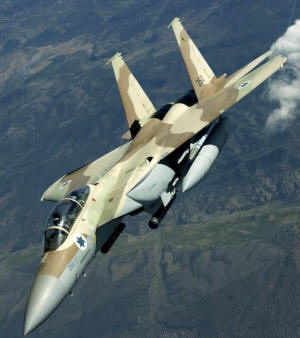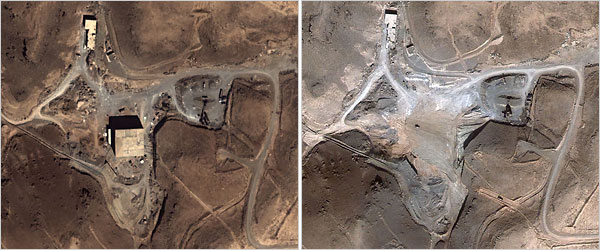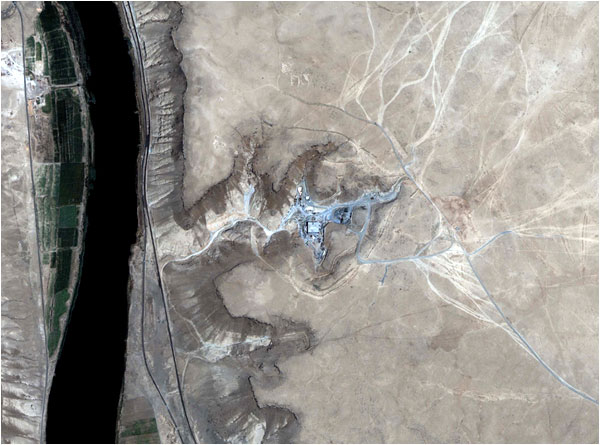- Beaumont, Peter. "Was Israeli raid a dry run for attack on Iran?", The Observer, 2007-09-16.
- Stephens, Bret. "Osirak II?", The Wall Street Journal, 2007-09-18.
- "Officials say Israel raid on Syria triggered by arms fears", Reuters, 2007-09-12.
- Mahnaimi, Uzi. "Israelis ‘blew apart Syrian nuclear cache’", The Sunday Times, 2007-09-16.
- "Turkish FM slams Israel over fuel tanks", The Jerusalem Post, 2007-09-10.
- Mahnaimi, Uzi. "Israelis ‘blew apart Syrian nuclear cache’", The Sunday Times, 2007-09-16.
- Raddatz, Martha. "EXCLUSIVE: The Case for Israel's Strike on Syria", ABC News, 2007-10-19.
- Mahnaimi, Uzi. "Snatched: Israeli commandos ‘nuclear’ raid", The Sunday Times, 2007-09-23.
- "Report: US stalled IAF raid in Syria fearing ME destabilization", The Jerusalem Post, 2007-10-06.
- Fulghum, David A.. "Why Syria's Air Defenses Failed to Detect Israelis", Aviation Week & Space Technology, 2007-10-03.
- Fulghum, David A.. "Israel used electronic attack in air strike against Syrian mystery target", Aviation Week & Space Technology, 2007-10-08.
- "Syria complains to U.N. about Israeli airstrike", CNN, 2007-09-11.
- Kessler, Glenn. "N. Korea, Syria May Be at Work on Nuclear Facility", The Washington Post, 2007-09-13.
- Melman, Yossi. "Records on N. Korean ship docked in Syria were altered", Haaretz, 2007-09-17.
- Kessler, Glenn. "Syria-N. Korea Reports Won't Stop Talks", The Washington Post, 2007-09-15.
- Butcher, Tim. "N Korean ship 'linked to Israel's strike on Syria'", The Daily Telegraph, 2007-09-17.
- Alexandrovna, Larisa. "Israeli air strike did not hit nuclear facility, intelligence officials say", The Raw Story, 2007-09-24.
- "Arab League center denies it was Israeli raid target", Middle East Times, 2007-09-30.
- "Assad sets conference conditions", BBC, 2007-10-01.
- "Report: Defecting Iranian official gave info before alleged Syrian foray", The Jerusalem Post, 2007-09-28.
- Sanger, David. "Israel Struck Syrian Nuclear Project, Analysts Say", The New York Times, 2007-10-14.
- "Turkey Asks Israel About Fuel Tanks", AP, 2007-09-09.
- "Israel admits air strike on Syria", BBC.
- "Turkey complains to Israel over fuel tanks found near border with Syria: reports", AP, 2007-09-09.
- Urquhart, Conal. "Speculation flourishes over Israel's strike on Syria", The Guardian, 2007-09-17.
- Harel, Amos. "ANALYSIS: Mummed media base IAF strike reports on world press", Haaretz, 2007-09-16.
- "Israel says deterrent ability recovered after Syria strike", AFP, 2007-09-16.
- "Speculation heats up over what Israel hit in Syria", AFP, 2007-09-16.
- "Netanyahu says Israel carried out Syria air raid, he backed it", AFP, 2007-09-19.
- Ephron, Dan. "The Whispers of War", Newsweek, 2007-10-01.
- "Olmert says he is ready to make peace with Syria", The Jerusalem Post, 2007-09-17.
- "Mysterious airstrike in northern Syria boosts Olmert's popularity: Poll", The Jerusalem Post, 2007-09-18.
- Oren, Amir. "IDF lifts censorship on air strike against Syria target", Haaretz, 2007-10-02.
- The consistency of error Haaretz 03/10/2007 The consistency of error By Amir Oren
- UN ships disrupt Israeli satellite TV, Breitbart.com Oct 10 05:37 AM US/Eastern
- An Israeli Strike on Syria Kindles Debate in the U.S. By MARK MAZZETTI and HELENE COOPER Published: October 10, 2007
- Satellite Photos Show Cleansing of Suspect Syrian Site By William J. Broad Published: October 26, 2007
- Broad, William, Mark Mazzetti. "Yet Another Photo of Site in Syria, Yet More Questions", The New York Times, 2007-10-27.
|
from Wikipedia Website
Operation Orchard[1][2] was an Israeli airstrike on a target in the Deir ez-Zor region[3] of Syria carried out just after midnight on September 6, 2007.
According to news reports, the raid was carried out by the Israeli Air Force's 69th Squadron of F-15Is,[4] F-16s, and an ELINT aircraft; a total of as many as eight aircraft.
The fighters were equipped with AGM-65 Maverick missiles, 500lb bombs, and external fuel tanks.[1][5] One report indicated that a team of IAF Shaldag commandos arrived at the site the day before so that they could highlight the target with laser beams.[6]
Israeli F-15I from
the 69th Squadron. Pre-strike activity
However, another report indicated that Israel planned to attack the site as early as July 14, but some US officials, including Secretary of State Condoleezza Rice, preferred a public condemnation of Syria, thereby delaying the military strike until Israel feared the information would leak to the press.[9]
The Times also reports that the mission
was "personally directed" by Israeli Defense Minister Ehud Barak. Radar detection
This would make it possible to feed enemy radar emitters with false targets, and even directly manipulate enemy sensors.
Syria is reported to have two new
state-of-the art Russian radar systems, suspected to be the Tor-M1
and Pachora-2A.[10][11]
Target
On September 13 The Washington Post reported that U.S. and Israeli intelligence gathered information on a nuclear facility constructed in Syria with North Korean aid, and that the target was a "facility capable of making unconventional weapons".[13]
According to The Sunday Times, the target was a cache of nuclear materials from North Korea.[6]
A North Korean ship had docked in Syria just a few days earlier,[14] and after the strike North Korea publicly condemned the raid; North Korea rarely comments on international events.[15] The ship was later identified as the Al Hamed, a 1,700-tonne cargo ship that was previously owned by a North Korean business.
The ship registered itself as South
Korean when it travelled through the Suez canal and docked at the
Syrian port Tartous on July 28. It returned on September 3, when it
was said to have unloaded cement. Records do not indicate where the
vessel is as of September 17.[16]
He did not provide any further details
about the nature of the structure or its purpose.[19] Reaction
On September 7-8 Turkish media reported finding Israeli fuel tanks in Hatay and Gaziantep Province, and the Turkish Foreign Minister lodged a formal protest with the Israeli envoy.[22][24]
Israel did not comment on the incident, although Israeli Prime Minister Ehud Olmert did say that,
Israeli papers were banned from doing their own reporting on the airstrike.[26] On September 16 the head of Aman, Amos Yadlin, told a parliamentary committee that Israel regained its "deterrent capability."[27]
US Defense Secretary Robert Gates was asked if North Korea was helping Syria in the nuclear realm, but replied only that,
The first public acknowledgment by an Israeli official came on September 19 when opposition leader Benjamin Netanyahu said that he had backed the operation and congratulated Prime Minister Olmert.[29]
Netanyahu advisor Uzi Arad later told Newsweek,
On September 17 Prime Minister Olmert announced that he was ready to make peace with Syria,
According to a poll done by the Dahaf Research Institute, Olmert's
approval rating rose from 25% to 35% after the airstrike.[32]
Aftermath
Further, the provider has not been able to troubleshoot the problem. The Israeli government alleges that the origin of the poor reception is the activity of,
No
explanation is given why the ships activity did not affect reception
prior to September 6th.[35]
Satellite images from
Aug. 10 and Oct. 24 by DigitalGlobe
On October 27, 2007 The New York Times reported that the imaging company Geoeye released an image of the building from September 16, 2003, and from this security analyst John Pike estimated that construction began in 2001.
A "senior intelligence official" also told the Times that the US has observed the site for years by spy satellite.[38]
A satellite photo
from Sept. 16, 2003, shows a large structure being built near a site
in Syria that was bombed last month by Israel.
Video
References
|
||||||||||||||||||||||||



